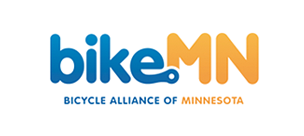6 Bicycle Types to Cruise, Explore, Commute, Shred Mountains, and more with!
Let’s explore some common and not so common kinds of bikes
Mountain Bikes
Sure there aren’t many mountains in Minnesota (though there are the Sawtooth Mountains along Lake Superior!) but there are many great reasons to have a mountain bike here. Mountain bikes are recognized by their wider tires, flat handlebars, and usually a front fork with built-in suspension or “shocks” and occasionally a rear suspension system as well. Mountain bikes are generally a bit heavier than the previous two bike styles mentioned as their frames need to be designed to withstand the abuse that comes with navigating rocks, tree roots, jumps and other features that can be found on the mountain bike trail. While hybrid and road bikes are generally 700c sized wheels, mountain bikes these days can be found in standard 26”, Fat Bike 26”, 27.5”, 650B, and 29”. I bet the industry released a new wheel size while I was typing this! The best way to pick a mountain bike is visit your local shop and chat with the staff there about what kind of mountain biking you’d like to do and take a few test rides. Even better, have your friends lend you their bike for a few laps on the local trail and see what you like!
For model examples check out the Surly Pugsley, Kona Honzo, Specialized Fuze, Rocky Mountain Growler, or Liv Pique.
Road Bikes
If speed is your need then you may want to consider a road-bike. Road bikes are generally most recognized by the presence of curved “drop” handlebars. However, the handlebar style isn’t the only difference. You’ll also generally experience a more aggressive forward leaning position by the design of a road bike to make the rider more aerodynamic and increase pedaling power. Road bikes often only have clearance for narrow skinny tires meant to run at high pressure to decrease rolling resistance and increase speed. They are typically much lighter weight than comparable hybrids or mountain bikes and don’t often have mounts for racks or fenders as they’re primarily designed to be lightweight and fast. There are many sub styles of road bikes too: triathlon bikes are even more aggressive in rider position and meant to go really fast in straight lines. Track bikes meant for the velodrome racing are fixed-gear bikes that don’t allow a rider to coast and only have 1 gear ratio. “Gravel, Bikepacking, and Touring” bikes may appear from a distance to be similar to road bikes but have wider tire clearance and more mounts for gear.
For road bike model examples look up the Trek Madone, Specialized Tarmac, Colnago Prestige, or the Giant Defy.
Hybrid Bikes
If you only have space or budget for one bike, it’s hard to beat the affordability and straight-forward utilitarian hybrid bike. Hybrids can certainly vary, but generally speaking they are a medium weight bicycle with straight handlebars, a relatively upright pedaling position, mounts for racks, fenders and water bottles and clearance for wider than road-racing specific tires. A hybrid bike is great for getting to work or school, going on a casual recreational ride, hauling a trailer with kids or the family dog, getting errands like grocery shopping done, or even some multi-day touring. Just about every major manufacturer has a hybrid model and many offer e-bike versions too.
Check out the Trek FX series, The Giant Escape, The Felt Verza, The Specialized Sirrus or Vita, The Cannondale Quick, The All-City Pony Express and more.
Adaptive Bikes
Not only does BikeMN’s bike fleet contain some amazing adaptive bikes, but we are also blessed to share a state with Twin Cities Adaptive Cycling that puts on many events using these great bicycles. Simply put, Adaptive Bicycles make it possible for nearly everyone to experience the joy and freedom of bicycling. They may take the form of trikes, hand cycles, tandem recumbents, side-by-side recumbents and more models seem to come onto the market all the time expanding where Adaptive Bikes can take riders.
Model examples include the Hase Bikes Pino, Reactive Wildcat Kids’ Handcycle, Vanraam Fun2Go Side by Side, and the Performer Family Tandem.
Cargo Bikes
The Cargo Bike has come a long way in the last 20 years in the United States and we’re finally getting to see some of the European designs and brands that we’ve long lusted over. A Cargo Bike has helped many families replace a car (or even go completely car free), transport weeks worth of groceries or other large/heavy items you wouldn’t think to carry on other bicycles, transport children, pets and even adults, or just look cool cruising around. E-bike Cargo Bike models make carrying even heavier loads for greater distances and managing hills a breeze!
In 2019 BikeMN hosted a webinar called Chain Chat with guest presenter Luke Breen of Perennial Bike Shop in Minneapolis. Luke said there are 4 main things to consider when shopping for a Cargo Bike. 1) Budget, 2) What do you want to carry?, 3) How much space do you have to store it?, and 4) Do you need e-assist? Answering these questions will determine what the ideal Cargo Bike for you might be.
Long tails, like the popular Surly Big Dummy, ride like a traditional bike and can maneuver with ease. They can also accommodate kids and any other gear you might be towing. However, the pilot may not be able to keep an as-attentive eye on any passengers or cargo since it’s all behind them.
Front loading cargo bikes, like the Urban Arrow Family Cargo Bike are great for families. The carrying capacity is comparatively large, and they’re easy to load up and hit the road. Steering of front loading bikes can take a little getting used to, but once you learn it becomes second nature.
For models look at the Yuba Spicy Curry, the compact Tern GSD, the RadWagon Electric Cargo, or Xtracycle.
E-Bikes
Electric Bikes or “E-Bikes” have exploded in popularity in recent years. While E-Bike versions can be found across all of the models above, they tend to fall into three distinct classes. Class 1 E-Bikes provide assistance only when rider is pedaling and ceases to provide assistance once the bicycle reaches 20 mph. Class 2 E-Bikes are capable of achieving up to 20 mph without requiring pedaling by using a “throttle.” Class 3 E-Bikes requiring pedaling for powered assistance but ceases to provide assistance once a speed of 28 mph is reached.
As mentioned in the previous category, E-Bikes are particularly useful for carrying heavy loads by bicycle but they also have enabled some families to give up a car or use their car less. Similarly, riders of different abilities and skill levels have found themselves able to climb hills, go further, and go faster than they may have ever dreamed of. Technology continues to improve making batteries lighter and longer lasting. At BikeMN we’re thrilled that E-Bikes have become popular even with those who didn’t previously ride traditional bicycles very often. More folks rolling on our trails and streets brings more voices demanding investment, safety, infrastructure, and advocacy.
For models consider the Specialized Turbo Cado, Trek Super Commuter+, Giant Roam E+, Xtracycle RFA.
Other Styles of Bikes
Sure, the above was an oversimplification of the many great bike styles there are out there. Here are just a few more that might meet your wants/needs. Fat Bikes, tandems, quad-cycles, recumbents, tricycles, beach cruisers, folding bikes, stationary (trainer) bikes, bike polo bikes, trial riding bikes, BMX freestyle and racing bikes, striders, single-speeds, fixed gears, mixte or “step-through” bikes, and plenty more I’m sure I didn’t name!

Theft Prevention & Recovery
Bicycle theft is an unfortunate reality. Between 2017 and 2019, there were 5,000 reported bike thefts in Minneapolis alone! Read on for some helpful tips about how to avoid losing your bike to thieves.Learn More

Bike Buying/Renting Cheat Sheet
Now that you’ve decided what kind of bike/s you want where should you get one? Learn More
